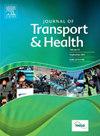Changes in biopsychosocial factors based on transportation independence among older adults: A one-year study post-COVID-19 movement restrictions
IF 3.2
3区 工程技术
Q2 PUBLIC, ENVIRONMENTAL & OCCUPATIONAL HEALTH
引用次数: 0
Abstract
Introduction
The global COVID-19 pandemic prompted widespread lockdown measures, impacting transportation systems and specifically affecting the mobility of older adults, which could result in changes to their biophysical, psychological and social health, or better known as biopsychosocial health. However, limited information exists regarding the alterations in the biopsychosocial aspects of older adults during and after the COVID-19 movement restrictions, as well as their association. The objective of this study is to investigate the biopsychosocial dynamics associated with navigating transportation during and after the recovery phase of COVID-19 pandemic. Additionally, it aims to determine the association between transportation independence status and various biopsychosocial factors.
Methods
A sub-sample of 100 individuals aged 60 years and above (mean age ± SD: 68.4 ± 5.3), from earlier cross-sectional study were recruited in a one year follow up study. Face-to-face interviews were conducted by the same researcher from baseline to obtain older adults’ sociodemographic health status, anthropometric measurements, functional status, depressive symptoms, nutritional status, cognitive status, visual assessment, physical activity and physical performance and transportation independence. Bivariate logistic regression was performed to examine the association.
Results
While there were no significant changes in transportation independence among older adults during and after the COVID-19 movement restriction, there were noticeable increases in outdoor mobility and certain changes in biopsychosocial factors. Results revealed higher fat mass (Adj OR = 1.20, 95% CI: 1.03–1.41, p < 0.05), poorer performance in Timed up and Go (TUG) (Adj OR = 1.40, 95% CI: 1.03–1.88, p < 0.05) test, poorer Hand Grip Strength (HGS) (Adj OR = .85, 95% CI: .74–.98, p < 0.05) and changes in Instrumental Activities of Daily Living (IADL) (p < 0.05) are associated with restricted transportation in older adults.
Conclusion
The findings of this study highlight the importance of biopsychosocial health factors, such as body composition, physical performance, and function, which may be influenced by transportation independence among older adults.
基于老年人交通独立性的生物心理社会因素变化:COVID-19 运动限制后的一年研究
导言 COVID-19 大流行在全球范围内引发了广泛的封锁措施,影响了交通系统,特别是影响了老年人的行动能力,这可能会导致他们的生物物理、心理和社会健康(或称为生物心理社会健康)发生变化。然而,关于 COVID-19 行动限制期间和之后老年人生物心理社会方面的变化及其关联的信息十分有限。本研究旨在调查 COVID-19 大流行恢复阶段期间和之后与交通导航相关的生物心理社会动态。方法在为期一年的随访研究中,从早期的横断面研究中招募了 100 名 60 岁及以上的个体(平均年龄 ± SD:68.4 ± 5.3)。由同一研究人员从基线开始进行面对面访谈,以了解老年人的社会人口健康状况、人体测量、功能状况、抑郁症状、营养状况、认知状况、视觉评估、体育活动和体能表现以及交通独立性。结果虽然在 COVID-19 运动限制期间和之后,老年人的交通独立性没有发生显著变化,但户外活动能力明显增加,生物心理社会因素也发生了某些变化。结果显示,老年人的脂肪含量更高(Adj OR = 1.20,95% CI:1.03-1.41,p < 0.05),在定时起跑(TUG)中表现较差(Adj OR = 1.40,95% CI:1.03-1.88, p < 0.05)测试、较差的手握力(HGS)(Adj OR = .85, 95% CI: .74-.98, p < 0.05)和日常生活工具性活动(IADL)的变化(p < 0.结论本研究的结果突出了生物心理社会健康因素的重要性,如身体成分、身体表现和功能,这些因素可能会影响老年人的交通独立性。
本文章由计算机程序翻译,如有差异,请以英文原文为准。
求助全文
约1分钟内获得全文
求助全文

 求助内容:
求助内容: 应助结果提醒方式:
应助结果提醒方式:


